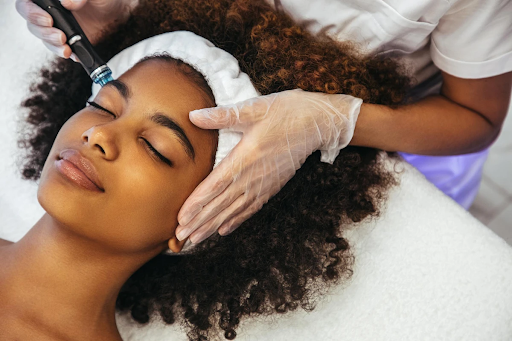Professional microneedling has become extremely popular for its ability to reduce the appearance of fine lines and dark spots. But, how does it work? In this blog, we're going to talk about the science of professional microneedling and how it rebuilds and rejuvenates the skin.
What is microneedling?
When done in a professional setting, microneedling is fantastic for the skin. Microneedling helps to stimulate the skin and remodel it from the inside out. It causes little microwounds in the skin that catalyze skin remodeling. This process is called the “wound healing cascade,” which is made up of four steps: hemostasis, inflammation, proliferation, and maturation.
What are the stages of wound healing?
Hemostasis
The first stage of wound healing is hemostasis. Hemostasis or "haemostasis" is a process to prevent and stop bleeding, meaning it keeps blood within a damaged blood vessel.
When you microneedle, you actually get a small wound, and your body doesn't want to bleed out. So, platelet cells are rushed to the area. “The platelets change shape and become stickier. This allows them to attach to the vessel wall and clump together into a plug. When there is an injury, platelets release molecules into the blood that help it to "clot" or stop bleeding. The platelets pull the two sides of the damaged vessel closer together, so it is easier to repair.”
Inflammation
After hemostasis, inflammation happens. People think of inflammation as a bad thing, but in some cases, it can be very helpful. Inflammation is when heat and swelling happen in an area. Inflammation occurs when your body recruits immune cells, neutrophils, and macrophages to fight off germs and pathogens.
These cells also contribute to the wound healing process and help to create more collagen. Actually, if we didn't have the inflammatory phase, microneedling would not be effective in creating more collagen and elastin. “Inflammation is a critical step in the normal process of wound healing and drives the proliferation of fibroblasts which synthesize collagen and elastin” (NIH, 2020).
At the same time, remember that inflammation can cause a lot of redness and irritation, and chronic inflammation or inflammation that doesn't stop is not good.
Proliferative phase
After this, we enter the proliferative phase. This is when your body creates new collagen and fibroblasts. Fibroblasts secrete collagen proteins that help maintain the structural framework or "firmness" of tissues. Collagen forms in the skin, and the maturation phase is entered.
Maturation phase
The maturation phase is when collagen is remodeled back into "type 1 Collagen." Type 1 collagen is primarily what gives skin suppleness, firmness, and bounciness. During the maturation phase, the skin fully closes the wound as well (Science Direct, 2019). New tissue begins to solidify and thicken.
What is special about wound healing during microneedling?
Microneedling or anything that stimulates the wound-healing cascade puts your skin through this process. But, microneedling does not simply create random wounds. With microneedling, you can control the depth of the needles and where they go on the skin. So, for things like scar revision, fine lines, microneedling works very well. There's even therapy that has microneedling plus radiofrequency like Secret by Cutera which is one of Cassandra's favorites.
What are the risks of microneedling?
When microneedling is done improperly, it can turn into a keloid scar which is a knotted, fibrous tissue. So, most microneedling treatments have to be done professionally in a clinic. However, many people purchase DIY derma rollers, which can cause so many things to go wrong. The ones that you roll across the skin are especially problematic because they create larger wounds that don't heal as well.
At least the stamp tools are a little more controlled, but Cassandra has always recommended talking to a professional first. It's important to do so before trying anything. That way, you can understand the risk, how to do it properly, what needle length is right, and how to sanitize things properly.

